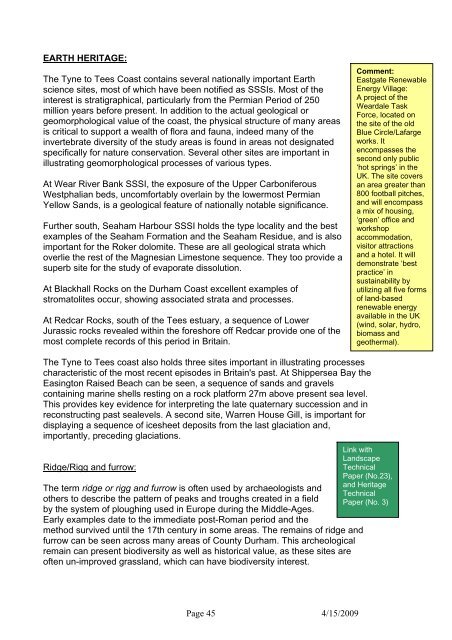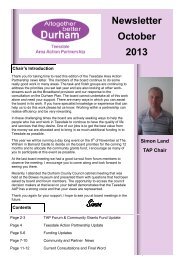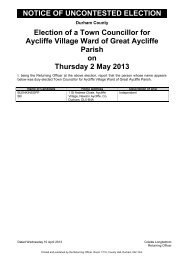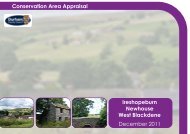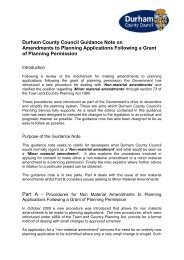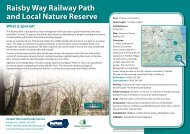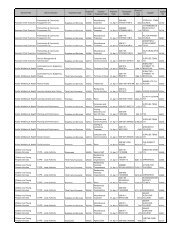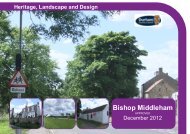SECTION 3.0 - Durham County Council
SECTION 3.0 - Durham County Council
SECTION 3.0 - Durham County Council
Create successful ePaper yourself
Turn your PDF publications into a flip-book with our unique Google optimized e-Paper software.
EARTH HERITAGE:<br />
The Tyne to Tees Coast contains several nationally important Earth<br />
science sites, most of which have been notified<br />
as SSSIs. Most of the<br />
interest<br />
is stratigraphical, particularly from the Permian Period of 250<br />
million years before present. In addition to the actual geological or<br />
geomorphological value of the coast, the physical structure of many areas<br />
is critical to support a wealth of flora and fauna, indeed many of the<br />
invertebrate diversity of the study areas is found in areas not designated<br />
specifically<br />
for nature conservation. Several other sites are important in<br />
illustrating<br />
geomorphological processes of various types.<br />
At Wear River Bank SSSI, the exposure of the<br />
Upper Carboniferous<br />
Westphalian<br />
beds, uncomfortably overlain by the lowermost Permian<br />
Yellow Sands, is a geological feature of nationally notable significance.<br />
Further south, Seaham Harbour SSSI holds the type locality and the best<br />
examples of the Seaham Formation and the Seaham Residue, and is also<br />
important for the Roker dolomite. These are all geological strata which<br />
overlie the rest of the Magnesian Limestone sequence. They too provide a<br />
superb site for the study of evaporate dissolution.<br />
At Blackhall Rocks on the <strong>Durham</strong> Coast excellent examples of<br />
stromatolites occur, showing associated strata and processes.<br />
At Redcar Rocks, south of the Tees estuary, a sequence of Lower<br />
Jurassic rocks revealed within the foreshore off Redcar provide one of the<br />
most complete records of this period in Britain.<br />
The Tyne to Tees coast also holds three sites important in illustrating processes<br />
characteristic of the most recent episodes in Britain's past. At Shippersea Bay the<br />
Easington Raised Beach can be seen, a sequence of sands and gravels<br />
containing marine shells resting<br />
on a rock platform 27m above present sea level.<br />
This provides key evidence<br />
for interpreting the late quaternary succession and in<br />
reconstructing past sealevels. A second site, Warren House Gill, is important for<br />
displaying a sequence<br />
of icesheet deposits from the last glaciation and,<br />
importantly, preceding glaciations.<br />
Comment:<br />
Eastgate Renewable<br />
Energy Village:<br />
A project of the<br />
Weardale<br />
Task<br />
Force,<br />
located on<br />
the site<br />
of the old<br />
Blue Circle/Lafarge<br />
works. It<br />
encompasses the<br />
second only public<br />
‘hot springs’ in the<br />
UK. The site covers<br />
an area greater than<br />
800 football pitches,<br />
and will encompass<br />
a mix of<br />
housing,<br />
‘green’ office and<br />
workshop<br />
accommodation,<br />
visitor attractions<br />
and a hotel. It will<br />
demonstrate<br />
‘best<br />
practice’<br />
in<br />
sustainability by<br />
utilizing<br />
all five forms<br />
of land-based<br />
renewable<br />
energy<br />
available<br />
in the UK<br />
(wind, solar,<br />
hydro,<br />
biomass and<br />
geothermal).<br />
Link with<br />
Landscape<br />
Ridge/Rigg and furrow:<br />
Technical<br />
Paper (No.23),<br />
and Heritage<br />
Th e term ridge or rigg<br />
and furrow is often used by archaeologists and<br />
Technical<br />
others to describe the pattern of peaks and troughs created in a field Paper (No. 3)<br />
by the system of ploughing used in Europe during the Middle-Ages.<br />
Early examples date to the immediate post-Roman period and the<br />
method<br />
survived until the 17th century in some areas. The<br />
remains of ridge and<br />
furrow can be seen across many areas of <strong>County</strong> <strong>Durham</strong>. This archeological<br />
remain can present biodiversity as well as historical value, as these sites are<br />
often un-improved grassland, which can have biodiversity interest.<br />
Page 45 4/15/2009


